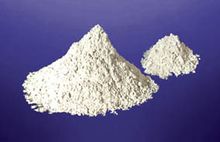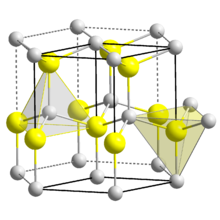نيتريد الألومنيوم

| |

| |
| الأسماء | |
|---|---|
| أسماء أخرى
Aluminium nitride
| |
| المُعرِّفات | |
| رقم CAS | |
3D model (JSmol)
|
|
| ChEBI | |
| ChemSpider | |
| ECHA InfoCard | 100.041.931 |
| رقم EC |
|
PubChem CID
|
|
| رقم RTECS |
|
CompTox Dashboard (EPA)
|
|
| |
| |
| الخصائص | |
| الصيغة الجزيئية | AlN |
| كتلة مولية | 40.99 g mol-1 |
| المظهر | white to pale-yellow solid |
| الكثافة | 3.260 g/cm3 |
| نقطة الانصهار | |
| نقطة الغليان | |
| قابلية الذوبان في الماء | hydrolyses (powder), insoluble (monocrystalline) |
| قابلية الذوبان | insoluble, subject of hydrolysis in water solutions of bases and acids [3] |
| الفجوة الحزمية | 6.015 eV [2] (direct) |
| حركية الإلكترون | ~300 cm2/(V·s) |
| التوصيل الحراري | 285 W/(m·K) |
| معامل الانكسار (nD) | 1.9–2.2 |
| البنية | |
| البنية البلورية | ڤورتسيت |
| الزمرة الفراغية | C6v4-P63mc |
| هندسة إحداثية |
رباعي الأسطح |
| الكيمياء الحرارية | |
| الإنتالپية المعيارية للتشكل ΔfH |
318 kJ/mol |
| Standard molar entropy S |
20.2 J/mol K |
| سعة الحرارة النوعية، C | 30.1 J/mol K |
| المخاطر | |
| NFPA 704 (معيـَّن النار) | |
ما لم يُذكر غير ذلك، البيانات المعطاة للمواد في حالاتهم العيارية (عند 25 °س [77 °ف]، 100 kPa). | |
| مراجع الجدول | |
نيتريد الألمنيوم (AlN) هو مركب كيميائي له الصيغة AlN ، يكون في حالته النقية على شكل بلورات ذو لون أبيض مزرق، تكون لها رائحة الأمونياك في الهواء الرطب. طور الڤورتسيت (w-AlN) هو wide band gap (6.01-6.05 eV عند درجة حرارة الغرفة) مادة شبه موصلة، مما يرشّحها للاستخدام المحتمل في إلكترونيات ضوئية فوق البنفسجية بعمق.
التاريخ
AlN was first synthesized in 1877, but it was not until the middle of the 1980s that its potential for application in microelectronics was realized[المصدر لا يؤكد ذلك] due to its relatively high thermal conductivity for an electrically insulating ceramic (70–210 W·m−1·K−1 for polycrystalline material, and as high as 285 W·m−1·K−1 for single crystals).[4]
الخواص
- يتفاعل نتريد الألمنيوم مع الماء محرراً غاز الأمونياك (النشادر)، بالإضافة إلى تشكل هيدروكسيد الألمنيوم حسب التفاعل
- يعد نتريد الألمنيوم من المركبات التي تمتاز بثباتيتها وقساوتها العالية (قساوتها 9 على مقياس موس Mohs )
- الرابطة الكيميائية في مركب نتريد الألمنيوم ليست شاردية (أيونية) بالكامل، حيث تساهم الرابطة المشتركة (تكافؤية) في ارتباط هذا المركب.
التحضير
يحضر نتريد الألمنيوم من تمرير غاز النيتروجين الجاف على معدن الألمنيوم عند 800°س
الاستخدامات
Epitaxially grown thin film crystalline aluminium nitride is used for surface acoustic wave sensors (SAWs) deposited on silicon wafers because of AlN's piezoelectric properties. One application is an RF filter which is widely used in mobile phones,[5] which is called a thin film bulk acoustic resonator (FBAR). This is a MEMS device that uses aluminium nitride sandwiched between two metal layers.[6]
Aluminium nitride is also used to build piezoelectric micromachined ultrasound transducers, which emit and receive ultrasound and which can be used for in-air rangefinding over distances of up to a meter.[7][8]
Metallization methods are available to allow AlN to be used in electronics applications similar to those of alumina and beryllium oxide. AlN nanotubes as inorganic quasi-one-dimensional nanotubes, which are isoelectronic with carbon nanotubes, have been suggested as chemical sensors for toxic gases.[9][10]
Currently there is much research into developing light-emitting diodes to operate in the ultraviolet using gallium nitride based semiconductors and, using the alloy aluminium gallium nitride, wavelengths as short as 250 nm have been achieved. In May 2006, an inefficient AlN LED emission at 210 nm was reported.[11]
There are also multiple research efforts in industry and academia to use aluminum nitride in piezoelectric MEMS applications. These include resonators, gyroscopes and microphones.[12][13]
Among the applications of AlN are
- opto-electronics,
- dielectric layers in optical storage media,
- electronic substrates, chip carriers where high thermal conductivity is essential,
- military applications,
- as a crucible to grow crystals of gallium arsenide,
- صناعة الصلب وأشباه الموصلات.
- نظراً لخصائصه الفيزيائية المميزة (معامل تمدد حراري صغير، ناقلية حرارية عالية، العزل الكهربائي) يستخدم نتريد الألمنيوم في التقنيات الكهربائية.
- يستخدم كوسيلة للصقل.
انظر أيضاً
الهامش
- ^ "Aluminium Nitride". Accuratus. Retrieved 2014-01-01.
- ^ Feneberg, M.; Leute, R. A. R.; Neuschl, B.; Thonke, K.; Bickermann, M. (2010). Phys. Rev. B. 82 (7): 075208. doi:10.1103/physrevb.82.075208.
{{cite journal}}: CS1 maint: untitled periodical (link) - ^ Fukumoto, S.; Hookabe, T.; Tsubakino, H. (2010). "Hydrolysis behavior of aluminum nitride in various solutions". J. Mat. Science. 35 (11): 2743–2748. doi:10.1023/A:1004718329003.
- ^ "AlN - Aluminium Nitride". Ioffe Database. Sankt-Peterburg: FTI im. A. F. Ioffe, RAN. Retrieved 2014-01-01.
- ^ "Apple, Samsung Cellphone Filter Orders Lift Avago".
- ^ "ACPF-7001: Agilent Technologies Announces FBAR Filter for U.S. PCS Band Mobile Phones and Data Cards". wirelessZONE. EN-Genius Network Ltd. 2002-05-27. Retrieved 2008-10-18.
- ^ "A Gestural Interface for Smart Watches".
- ^ Przybyla, R. (2014). "3D Ultrasonic Gesture Recognition". International Solid State Circuits Conference: 210–211.
- ^ Ahmadi, A; Hadipour, NL; Kamfiroozi, M; Bagheri, Z (2012). "Theoretical study of aluminium nitride nanotubes for chemical sensing of formaldehyde". Sensors and Actuators B: Chemical. 161 (1): 1025–1029. doi:10.1016/j.snb.2011.12.001.
- ^ Ahmadi Peyghan, A; Omidvar, A; Hadipour, NL; Bagheri, Z; Kamfiroozi, M (2012). "Can aluminum nitride nanotubes detect the toxic NH3 molecules?". Physica E. 44 (7–8): 1357–1360. doi:10.1016/j.physe.2012.02.018.
- ^ Y. Taniyasu; et al. (2006). "An Aluminium Nitride Light-Emitting Diode with a Wavelength of 210 Nanometres". Nature. 441 (7091): 325–328. doi:10.1038/nature04760. PMID 16710416.
- ^ http://www.sand9.com Archived 2011-11-04 at the Wayback Machine
- ^ http://www.vespermems.com
وصلات خارجية
- Jaime Andrés Pérez Taborda; J.C. Caicedo; M. Grisales; W. Saldarriaga; H. Riascos (2015). "Deposition pressure effect on chemical, morphological and optical properties of binary Al-nitrides". Optics. 69: 92–103. doi:10.1016/j.optlastec.2014.12.009.
| الأملاح والمشتقات المكافئة لأيون النيتريد | |||||||||||||||||||
|---|---|---|---|---|---|---|---|---|---|---|---|---|---|---|---|---|---|---|---|
| NH3 | He(N2)11 | ||||||||||||||||||
| Li3N | Be3N2 | BN | β-C3N4 g-C3N4 |
N2 | NxOy | NF3 | Ne | ||||||||||||
| Na3N | Mg3N2 | AlN | SiN | PN P3N5 |
SxNy SN S4N4 |
NCl3 | Ar | ||||||||||||
| K3N | Ca3N2 | ScN | TiN | VN | CrN Cr2N |
MnxNy | FexNy | CoN | Ni3N | CuN | Zn3N2 | GaN | Ge3N4 | As | Se | NBr3 | Kr | ||
| Rb3N | Sr3N2 | YN | ZrN | NbN | β-Mo2N | Tc | Ru | Rh | PdN | Ag3N | CdN | In | Sn | Sb | Te | I | Xe | ||
| Cs3N | Ba3N2 | Hf3N4 | TaN | WN | Re | Os | Ir | Pt | Au | Hg3N2 | TlN | Pb | BiN | Po | At | Rn | |||
| Fr | Ra | Rf | Db | Sg | Bh | Hs | Mt | Ds | Rg | Cn | Nh | Fl | Mc | Lv | Ts | Og | |||
| ↓ | |||||||||||||||||||
| La | CeN | Pr | Nd | Pm | Sm | Eu | GdN | Tb | Dy | Ho | Er | Tm | Yb | Lu | |||||
| Ac | Th | Pa | UN | Np | Pu | Am | Cm | Bk | Cf | Es | Fm | Md | No | Lr | |||||
